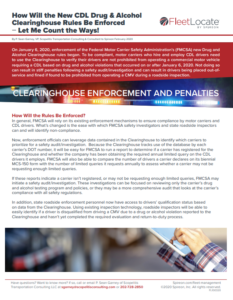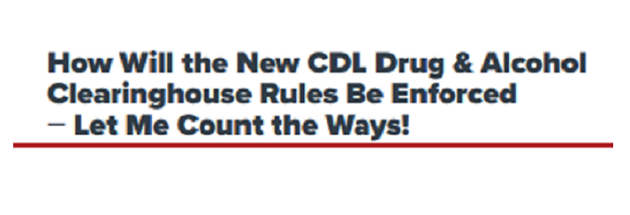Drug and Alcohol Clearinghouse enforcement: Now that the Clearinghouse is well underway, many carriers and drivers are wondering what shape the enforcement will take.
On January 6, 2020, enforcement of the Federal Motor Carrier Safety Administration’s (FMCSA) new Drug and Alcohol Clearinghouse rules began. To be compliant, motor carriers who hire and employ CDL drivers need to use the Clearinghouse. This process will verify their drivers are not prohibited from operating a commercial motor vehicle requiring a CDL based on drug and alcohol violations that occurred on or after January 6, 2020. Not doing so can result in stiff penalties following a safety audit/investigation. It can also result in drivers being placed out-of-service and fined if found to be prohibited from operating a CMV during a roadside inspection.
Already, industry publications are reporting that the Clearinghouse has detected more than 8,000 violations since its launch. And yet, reports also indicate that drivers who fail a drug test could go months before getting noticed in the FMCSA database.
So it seems that, just as with the ELD roadside enforcement, the industry is looking for guidance on what shape the enforcement will take, and what they should do.
Unfortunately, the FMCSA website doesn’t provide clear guidance on this subject.
 What Can You Expect in Drug and Alcohol Clearinghouse Enforcement?
What Can You Expect in Drug and Alcohol Clearinghouse Enforcement?
So, we’re pleased to say that our partners at Scopelitis Transportation Consulting has drafted a quick-read report on what you can expect in terms of:
- How will the rules be enforced?
- What should you expect from roadside enforcement personnel?
- What are the penalties for non-compliance?
- And more
You can find this and other informative reports on the Drug and Alcohol Clearinghouse in our new Drug and Alcohol Clearinghouse Resource Center.
To get a copy of the Drug & Alcohol Clearinghouse Enforcement report, click on the button below.


